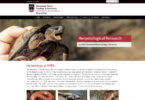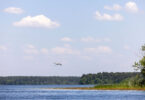Athens, Ga. – If you hear frogs calling and it seems like the wrong time of year, scientists say it may be due to climate change. Researchers from the University of Georgia Savannah River Ecology Laboratory, writing in the Proceedings of the Royal Society B, suggest that the breeding periods of several salamander and frog species have shifted over the last thirty years, possibly due to changes in temperature and precipitation patterns.
Many fish-free isolated wetlands are important breeding sites for frogs, toads and salamanders. In the Southeast, some wetlands may have 20 or more species that migrate to the ponds throughout the year, with some species arriving to breed in the fall, followed by others migrating in winter, spring or summer. The SREL scientists discovered that the timing of this migration for four species has changed significantly in recent years, with two of the fall breeders migrating weeks later, and two winter breeding species earlier, than they did at the beginning of the study. Delayed and advanced breeding may be related to warmer fall/winter temperatures over the years.
Co-author David Scott, a research assistant at the SREL, has helped conduct the research for twenty-seven of the thirty-two-year study. “These data are some of the best in the world for examining how species may respond to a changing climate,” said Scott. “Observing that species respond differently is a start toward predicting how environmental change may affect this group of animals in the decades to come. But there is still a great deal we don’t know about how their habitats might change.”
The study was initiated at a wetland called Rainbow Bay on the Department of Energy’s Savannah River Site, and for many years has been funded by DOE as a reference site to compare to other wetlands that have been altered by construction activity or trace metals. Co-author Whit Gibbons, professor emeritus in the UGA Odum School of Ecology, said, “The Rainbow Bay study is especially relevant in having been recognized as the longest running field study on amphibians in the world, with the trapping system having been set up in September 1978 by SREL and checked daily-holidays, weekends, snow days, you name it- for amphibians since that time.” In addition to serving as a reference site for some of the laboratory’s ecotoxicology studies, it has proven extremely valuable for understanding the basic ecology of amphibians, according to Gibbons.
“Understanding how climate variables affect wildlife is complicated,” said Scott, “and long-term data sets are a must to be able to identify trends.” It is only because of the long-term nature of the study that the researchers could discern the gradual shifts in breeding times, said the authors.
“Some impacts in nature are abrupt and noticeable, while others are much more subtle-a species change in breeding habits tends to happen slowly over time,” said Scott.
Co-author Brian Todd, now at the University of California at Davis, notes “The rates of change in reproductive timing in our study are among the fastest reported for any ecological events. Our results highlight the sensitivity of amphibians to environmental change and provide cause for concern in the face of continued climate warming.”
Joe Pechmann, co-author at Western Carolina University, stated, “Observing significant breeding shifts in four of the five earliest breeding species at our site is significant-temperature may have a greater effect on the timing of early breeders than of late breeders, and our data support this generalization.”
For more information on the Savannah River ecology Lab, see http://www.srel.edu/.







